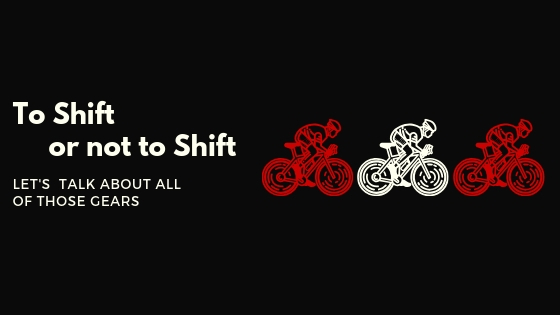If you’re a little confused and uncertain about shifting gears on your bicycle – you’re not alone so I’ve decided to dedicate this post on the topic. For the purpose of this post, I’ll be writing about a bike with 3 sprockets in the front, and 8 in the rear which represents about half of the hybrids and mountain bikes I’ve seen. Having multiple gears available on your bike makes getting around easier, more efficient and more fun. Note that you don’t have to be a physicist or engineer to properly use all of the gears on your bike so don’t get intimidated with all the hardware – (i.e. cables, derailleurs, chain and shifters).  All you have to do is respond to the power required to turn the pedals. Thanks to gravity, when the road begins to rise, the pedaling gets harder – that’s a good time to shift. When you crest the hill and start down the other side, the pedaling gets easy to the point that you can’t keep up with the pedals – that’s also a good time to shift. But there’s a shifter on the left, and there’s a shifter on the right and both can shift one way or the other. That’s where it can get confusing. Relax, Let me walk you through it.
All you have to do is respond to the power required to turn the pedals. Thanks to gravity, when the road begins to rise, the pedaling gets harder – that’s a good time to shift. When you crest the hill and start down the other side, the pedaling gets easy to the point that you can’t keep up with the pedals – that’s also a good time to shift. But there’s a shifter on the left, and there’s a shifter on the right and both can shift one way or the other. That’s where it can get confusing. Relax, Let me walk you through it.
The shifter on the left controls which front chain ring you’re in – small, middle or large (1st, 2nd or 3rd gear). It’s the shifter used the least, and my advice is to always start in the middle chain ring. In fact, leave it in the middle for now until you’re comfortable with using the right shifter. The right shifter controls which rear sprocket you’re in – 1,2,3,4,5,6,7 or 8. The gear you’re in is displayed on the shifter itself, but I don’t want you pay any attention to the numbers – in fact, I don’t want you to worry about which direction to shift either. Stay with me – Your instructions are to be in the middle front chain ring, so once it’s there, we’re not going to worry about the left shifter anymore – got it.
So, go ahead and start riding your bike. It might be in an easy gear and it might be in a hard gear, or maybe even just right. No one knows but you, and you have the power to do something about it. Let’s say it’s just right, and you’re comfortable riding along, but you’re facing a hill. From experience, you know that the pedaling is going to get harder, and it’s good to anticipate these things, so it’s time to shift. We know 2 things – we’ll be shifting with the right shifter, and we can shift two different ways. We’re talking about a learning situation here, and I don’t want to make things complicated.  I’m here to tell you, it doesn’t matter which way you shift. Just understand this – if it gets easier, you shifted correctly and if it gets harder you’ve got time to fix it. Don’t get flustered. You didn’t break anything, so simply shift twice the other direction. That’s all there is to it. Anticipate the shift, shift then deal with the consequences. If the hill continues or starts to rise, shift again. Still too hard, shift again. Realize that you won’t be correcting your shifting mistakes for long, because since you’re only using the right shifter, you’ll quickly learn which way makes it easier and which way makes it harder.
I’m here to tell you, it doesn’t matter which way you shift. Just understand this – if it gets easier, you shifted correctly and if it gets harder you’ve got time to fix it. Don’t get flustered. You didn’t break anything, so simply shift twice the other direction. That’s all there is to it. Anticipate the shift, shift then deal with the consequences. If the hill continues or starts to rise, shift again. Still too hard, shift again. Realize that you won’t be correcting your shifting mistakes for long, because since you’re only using the right shifter, you’ll quickly learn which way makes it easier and which way makes it harder.
You crest the hill and begin to descend. The pedaling gets easy – in fact, you cannot keep up with the pedals, so shift to make it harder. Still too easy, shift again, and again, and again……. or you can stop pedaling completely and coast.
Congratulations, you’ve mastered the art of shifting with the right shifter. Now, what about the left shifter.? We should still be in the middle ring, and once again, we’re approaching a hill, so you downshift like we just learned. Pedaling gets harder, downshift again. Harder again – downshift again. We downshift, downshift, downshift until we cannot shift any further. We run out of gears. Now we turn to the left shifter. Shift to the small chain ring up front, and, like magic, you have additional low gears! The front chain rings expand the range which you have to choose from. Once again, the left shifter will make pedaling even easier. (Mountain bikers call this the “granny gear”)
Harder again – downshift again. We downshift, downshift, downshift until we cannot shift any further. We run out of gears. Now we turn to the left shifter. Shift to the small chain ring up front, and, like magic, you have additional low gears! The front chain rings expand the range which you have to choose from. Once again, the left shifter will make pedaling even easier. (Mountain bikers call this the “granny gear”)
Now, at the other end of the spectrum, you’re flying down a hill. Upshift – faster, upshift – faster, upshift again until you’re out of gears. When you’re out of gears, turn to the left shifter. Shift to the big ring and the range is expanded. Go even faster…. and you don’t even have to be coming down a hill to go fast. Test your strength and endurance by starting with an easy gear, upshifting, going faster, upshifting, going even faster. Run out of gears – big ring – BOOM – you’re going fast on the flats. Now that’s what I’m talking about.
A couple of things: when shifting right or left / up or down – always be pedaling and also when shifting – only shift one gear at a time. I repeat – always be pedaling, and only one gear at a time – got it.
The road ahead goes up and down, and now that you’ve mastered your gears, riding is better, more efficient and more fun. With a wide range of gears you’ve literally expanded your horizons. Don’t worry about all of the moving parts – that’s Bike Werk’s job! Congratulations on your new skill – now go ride your bike!
